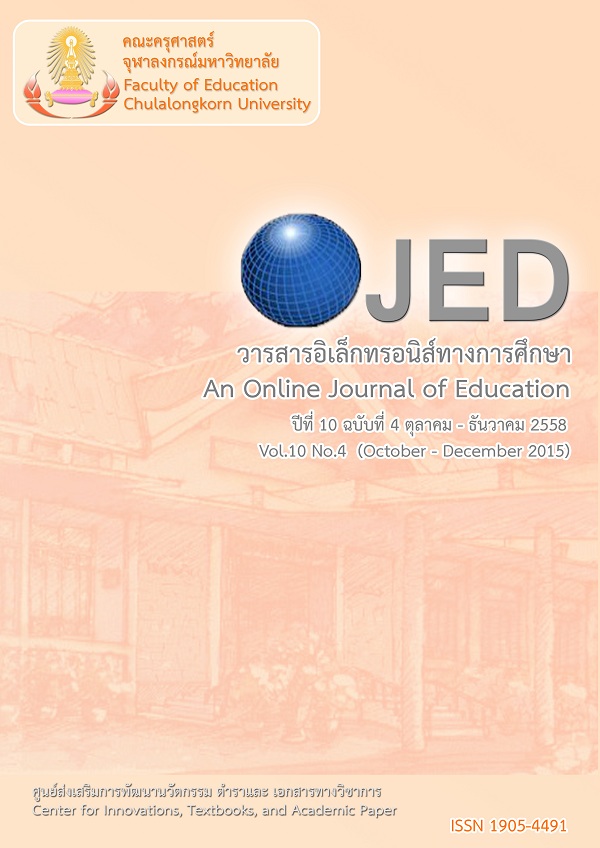ผลของการใช้โปรแกรมการกำกับตนเอง ที่มีต่อคุณลักษณะอยู่อย่างพอเพียงของนักเรียนมัธยมศึกษาปีที่ 1
Keywords:
โปรแกรมการกำกับตนเอง, คุณลักษณะอยู่อย่างพอเพียง, SELF-REGULATION, SUFFICIENCY CHARACTERISTICAbstract
งานวิจัยครั้งนี้เป็นวิจัยกึ่งการทดลอง มีวัตถุประสงค์เพื่อ 1) เพื่อศึกษาผลของโปรแกรมการกำกับตนเองที่มีต่อคุณลักษณะอยู่อย่างพอเพียง 2)เพื่อเปรียบเทียบผลการใช้โปรแกรมการกำกับตนเองที่มีต่อคุณลักษณะอยู่อย่างพอเพียงระหว่างกลุ่มทดลองและกลุ่มควบคุม กลุ่มตัวอย่างคือ นักเรียนชั้นมัธยมศึกษาปีที่ 1 ภาคเรียนที่ 2 ปีการศึกษา 2557 โรงเรียนวิชูทิศ สังกัดกรุงเทพมหานคร จำนวน 2 ห้องเรียน เครื่องมือที่ใช้ในงานวิจัยคือ โปรแกรมการกำกับตนเอง แบบวัดคุณลักษณะอยู่อย่างพอเพียง แบบสังเกตพฤติกรรมคุณลักษณะอยู่อย่างพอเพียงโดยครู และแบบสังเกตพฤติกรรมคุณลักษณะอยู่อย่างพอเพียงโดยนักเรียน วิเคราะห์ข้อมูลด้วยสถิติ One way ANOVA repeated measure
และ t-test
ผลการวิจัยพบว่า 1) ระยะหลังการทดลองนักเรียนกลุ่มทดลองมีคะแนนคุณลักษณะอยู่อย่างพอเพียงสูงกว่าระยะก่อนการทดลอง อย่างมีนัยสำคัญทางสถิติที่ระดับ .05 2) ระยะหลังการทดลองนักเรียนกลุ่มทดลองมีคะแนนคุณลักษณะอยู่อย่างพอเพียงสูงกว่ากลุ่มควบคุม อย่างมีนัยสำคัญทางสถิติที่ระดับ .05 3) ระยะติดตามผลนักเรียนกลุ่มทดลองมีคะแนนคุณลักษณะอยู่อย่างพอเพียงไม่แตกต่างกับระยะก่อนการทดลอง อย่างมีนัยสำคัญทางสถิติที่ระดับ .05 และ 4) ระยะติดตามผลนักเรียนกลุ่มทดลองมีคะแนนคุณลักษณะอยู่อย่างพอเพียงแตกต่างกับกลุ่มควบคุม อย่างมีนัยสำคัญทางสถิติที่ระดับ .05
This study describes a quasi-experimental design that aimed to evaluate the effectiveness of self-regulation program to promote sufficiency characteristic of eleventh grade students. The data were collected by 1) Sufficiency characteristic’s test, 2) The observed behavior of sufficiency characteristic by teacher, and 3) The observed behavior of sufficiency characteristic by student. One-way repeated measure ANOVA and T-test were employed for data analysis. Results showed (1) After participating
a self-regulation program, experimental group students significantly gained higher sufficiency characteristic’s scores. (2) Experimental group students significantly received higher posttest scores of sufficiency characteristic’s test than control group students. (3) Delayed-posttest scores of sufficiency characteristic’s test of experimental group students were not significantly different comparing to their pre-test scores. And (4) Delayed-posttest scores of sufficiency characteristic’s test of experimental group students and those of control group students were significantly different. Implications for self-regulation program, theory, research, and intervention are discussed.




